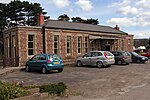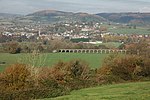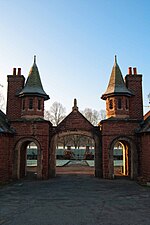Troy House
Country houses in MonmouthshireGrade II* listed buildings in MonmouthshireHistory of MonmouthshireRegistered historic parks and gardens in Monmouthshire

Troy House is a Welsh historic house, on a "ducal" scale, north-east of Mitchel Troy, Monmouthshire. The original house belonged to Blanche Herbert, Lady Troy, of the Herbert family of Raglan Castle, who owned great estates in South Wales as Marquesses of Worcester and later Dukes of Beaufort. The present structure, overlooking the River Trothy was constructed from 1681 to 1684 as a wedding present for Charles Somerset by his father, Henry Somerset, 1st Duke of Beaufort. Troy House is a Grade II* listed building and its gardens and park are listed, also at Grade II*, on the Cadw/ICOMOS Register of Parks and Gardens of Special Historic Interest in Wales.
Excerpt from the Wikipedia article Troy House (License: CC BY-SA 3.0, Authors, Images).Troy House
Geographical coordinates (GPS) Address Nearby Places Show on map
Geographical coordinates (GPS)
| Latitude | Longitude |
|---|---|
| N 51.7987 ° | E -2.7129 ° |
Address
NP25 4HX , Mitchel Troy
Wales, United Kingdom
Open on Google Maps








